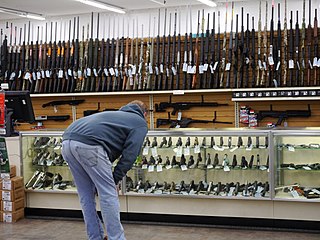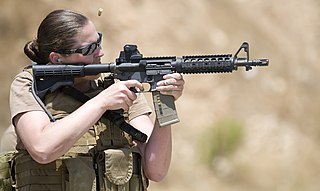 W
WThis is a list of countries by estimated number of privately owned guns per 100 persons. The Small Arms Survey 2017 provides estimates of the total number of civilian-owned guns in a country. It then calculates the number per 100 persons. This number for a country does not indicate the percentage of the population that owns guns. This is because individuals can own more than one gun.
 W
WThis is a list of countries that gives the percent of households with guns. It is further broken down by the percent of households with handguns. Also, by the percent of adults living in armed households. The data is from GunPolicy.org which is hosted by the Sydney Medical School, at the University of Sydney in Australia. GunPolicy.org consolidates this data from various sources. To avoid problems with vetting the data for hundreds of countries from hundreds of sources, the table below only uses data compiled by GunPolicy.org.
 W
WOpposition to hunting is espoused by people or groups who object to the practice of hunting, often seeking anti-hunting legislation and sometimes taking on acts of civil disobedience, such as hunt sabotage. Anti-hunting laws, such as the English Hunting Act 2004, are generally distinguishable from conservation legislation like the American Marine Mammal Protection Act by whether they seek to reduce or prevent hunting for perceived cruelty-related reasons or to regulate hunting for conservation, although the boundaries of distinction are sometimes blurred in specific laws, for example when endangered animals are hunted.
 W
WArms trafficking or gunrunning is the illicit trade of contraband small arms and ammunition, which constitutes part of a broad range of illegal activities often associated with transnational criminal organizations. The illegal trade of small arms, unlike other organized crime commodities, is more closely associated with exercising power in communities instead of achieving economic gain. Scholars estimate illegal arms transactions amount to over US$1 billion annually.
 W
WConcealed carry, or carrying a concealed weapon (CCW), is the practice of carrying a weapon, either on one's person or in close proximity, in public places in a manner that hides or conceals the weapon's presence from the surrounding observers. The opposite of concealed carry is called open carry.
 W
WDefense Distributed is an online open-source hardware organization that develops digital schematics of firearms in CAD files, or "wiki weapons", that may be downloaded from the Internet and used in 3D printing or CNC milling applications. Among the organization's goals is to develop and freely publish firearms-related design schematics that can be downloaded and reproduced by anyone with a 3D printer or milling machine, facilitating the popular production of ghost guns.
 W
WGun control is the set of laws or policies that regulate the manufacture, sale, transfer, possession, modification, or use of firearms by civilians.
 W
WIn the United States, gun culture encompasses the behaviors, attitudes, and beliefs about firearms and their usage by civilians. Gun ownership in the United States is the highest in the world, and constitutionally protected by the Second Amendment to the United States Constitution. Firearms are widely used in the United States for self-defense, hunting, and recreational uses, such as target shooting.
 W
WGun ownership is the act of owning a gun. In 2018, Small Arms Survey reported that there are over one billion small arms distributed globally, of which 857 million are in civilian hands. The Small Arms Survey stated that U.S. civilians alone account for 393 million of the worldwide total of civilian held firearms. This amounts to "120.5 firearms for every 100 residents."
 W
WGun-related violence is violence committed with the use of a gun. Gun-related violence may or may not be considered criminal. Criminal violence includes homicide, assault with a deadly weapon, and suicide, or attempted suicide, depending on jurisdiction. Non-criminal violence includes accidental or unintentional injury and death. Also generally included in gun violence statistics are military or para-military activities.
 W
WYoshihiro Hattori was a Japanese student on an exchange program to the United States who was shot to death in Baton Rouge, Louisiana. He was on his way to a Halloween party and went to the wrong house by mistake. Property owner Rodney Peairs fatally shot Hattori, thinking that he was trespassing with criminal intent. The shooting and Peairs' acquittal in the state court of Louisiana received worldwide attention.
 W
WFrederick William "Gunner" Hill is best known for his pre-war calculations that showed that the high speed fighters then being developed would need to be armed with eight machine guns in order for them to become the potent weapons that were crucial to the victory in the Battle of Britain. Captain Hill's technical skills were important in arming aircraft in both World Wars. In World War I he trialled methods of mounting machine guns in aircraft, evaluated heavy aircraft guns including the 37mm Coventry Ordnance Works (COW) gun, tested ammunition to be used against Zeppelins including the Brock bullet and designed and developed aircraft gun sights. In the inter-war period he worked at the Air Ministry where he continued to work on aircraft gun sights as well as showing how they could best be armed with the weapons then available. He made key contributions to the development of the GM2 reflector gunsight that helped the allies gain air superiority over Germany.
 W
WA militia is generally an army or some other fighting organization of non-professional soldiers, citizens of a country, or subjects of a state, who may perform military service during a time of need, as opposed to a professional force of regular, full-time military personnel or (historically) to members of a warrior nobility class. Generally unable to hold ground against regular forces, militias commonly support regular troops by skirmishing, holding fortifications, or conducting irregular warfare, instead of undertaking offensive campaigns by themselves. Local civilian laws often limit militias to serve only in their home region, and to serve only for a limited time; this further reduces their use in long military campaigns.
 W
WMiss Sloane is a 2016 political thriller film directed by John Madden and written by Jonathan Perera. The film stars Jessica Chastain, Mark Strong, Gugu Mbatha-Raw, Michael Stuhlbarg, Alison Pill, Jake Lacy, John Lithgow, and Sam Waterston. The film follows Elizabeth Sloane, a fierce lobbyist, who fights in an attempt to pass gun control legislation. However, she is left helpless when the opposing party digs deep into her personal life.
 W
WOpen Carry Guitar Rally is a concept created by Barry Kooda in response to the Open Carry gun movement. During an Open Carry Guitar Rally, citizens congregate in a public place while displaying their instruments, a parody of similar gatherings held by gun rights activists.
 W
WThe Postenpflicht was a general order issued to SS-Totenkopfverbände guards in Nazi concentration camps to summarily execute insubordinate prisoners. The order required guards to shoot prisoners who engaged in resistance or escape attempts, without warning; failing to do so would result in dismissal or arrest. The Postenpflicht was originally issued on October 1, 1933, for guards at Dachau concentration camp, but was later extended to other concentration camps.
 W
WThe right to keep and bear arms is a right for people to possess weapons (arms) for their own defense. Only a few countries recognize an individual right to keep and bear arms and protect it constitutionally, with more classifying it as a statutory privilege granted to some segment of the population.
 W
WSmall Arms and Light Weapons (SALW) refers in arms control protocols to two main classes of man-portable weapons."Small arms", broadly speaking, are individual-service kinetic projectile firearms. These include: handguns, muskets/rifled muskets, shotguns, rifles, submachine guns/personal defense weapons, squad automatic weapons and light machine guns."Light weapons", broadly speaking, are infantry-portable weapons that are either crew-served kinetic firearms, incendiary devices, or shoot explosive munitions. These include: anti-materiel rifles/anti-tank rifles, general-purpose machine guns/medium machine guns, unmounted heavy machine guns, portable flamethrowers, grenades, rifle grenades/underslung grenade launchers, grenade launchers, automatic grenade launchers, recoilless rifles, rocket-propelled grenades, man-portable anti-tank missiles, man-portable air-defense systems and mortars under 100 millimetres (3.9 in) caliber.
 W
WSchießbefehl was the term in the German Democratic Republic for standing orders authorizing the use of lethal force by the Border Troops to prevent Republikflucht at the Inner German border from 1960 to 1989.
 W
WA firearm is any type of gun designed to be readily carried and used by an individual. The term is legally defined further in different countries.
 W
WUnintended Consequences is a novel by John Ross, first published in 1996 by Accurate Press. The story chronicles the history of gun culture, gun rights, and gun control in the United States from the early 20th century through the late 1990s. Although clearly a work of fiction, the story is heavily laced with historical fact, including historical figures who play minor supporting roles. The protagonist is very active in competitive shooting sports, as is the author; so unusually detailed and intricate facts, figures, and explanations of firearms-related topics ornament the narrative and drive the plot.